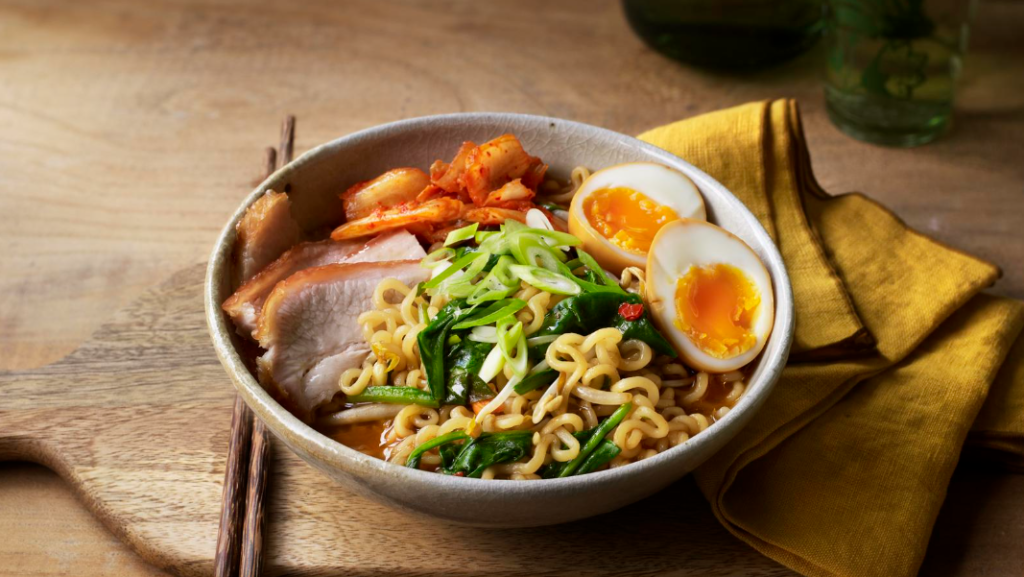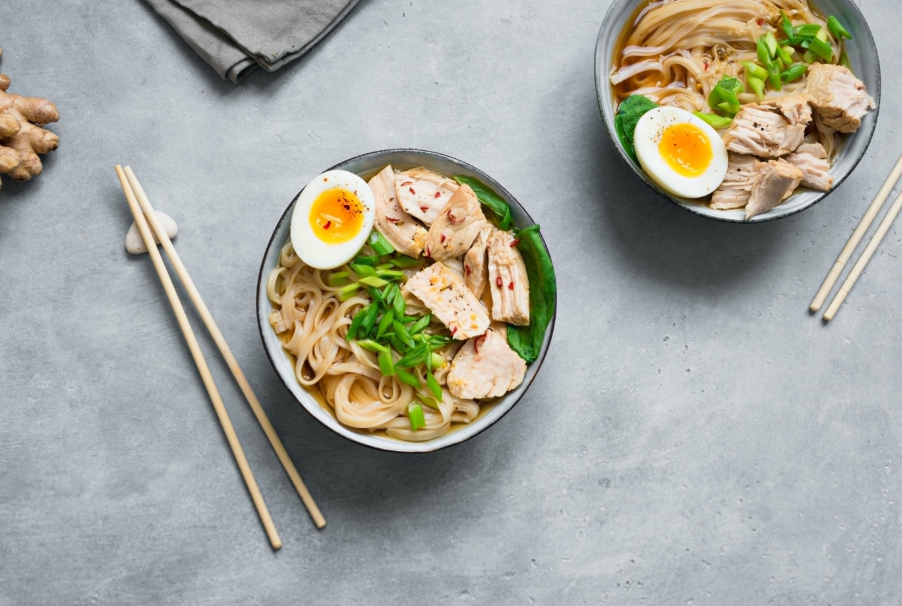How to Make Ramen Noodles at Home

Ramen noodles are quite possibly of the most notorious and soothing dish on the planet. Starting in Japan, ramen has turned into a worldwide #1, cherished for its rich stocks, delicate noodles, and vast opportunities for garnishes. While moment ramen has made the dish advantageous and reasonable, nothing beats the taste and fulfillment of making ramen without any preparation. Assuming that you’ve at any point considered how to make ramen noodles at home, this recipe will direct you through a straightforward yet tasty interaction that doesn’t need particular gear.
Natively constructed ramen noodles are new, adaptable, and a lot more grounded than locally acquired assortments, as you have some control over the fixings and make them as you would prefer. Whether you’re making a fast feast or planning for a unique supper, this simple ramen noodle recipe will make them partake in a bowl of delightful natively constructed ramen in a matter of seconds.
Ingredients for Ramen Noodles
Before you begin setting up the noodles, ensure you have every one of the essential fixings. Here is a breakdown of what you’ll require for the ramen batter, alongside discretionary fixings to lift the flavor.
Basic Ingredients:
| Ingredient | Quantity |
| Generally useful flour | 2 cups |
| Water | 2/3 cup |
| Baking soda | 1 tsp |
| Salt | 1/2 tsp |
| Cornstarch (for dusting) | As required |
Optional for Flavoring:
| Ingredient | Quantity |
| Egg (for added richness) | 1 |
| Soy sauce | 1 tsp |
| Sesame oil | 1 tsp |
The vital elements for making ramen noodles at home incorporate flour, water, and baking pop. You can likewise consolidate an egg to improve the surface of the noodles, or use soy sauce and sesame oil for extra character.
Why These Ingredients Matter:
- Flour: The foundation of any noodle batter, everything reason flour is utilized here to make delicate, chewy noodles.
- Baking Pop: An exceptional fixing in ramen noodles, baking soft drink makes the mark surface of ramen, which is somewhat firmer and chewier than different kinds of noodles.
- Egg: Discretionary, yet adding an egg can make your batter more extravagant, working on the flavor and making a smoother surface.
Step-by-Step Preparation Method

Making ramen noodles without any preparation is a tomfoolery interaction that includes a couple of essential advances. How about we stroll through the strategy exhaustively, from setting up the mixture to cooking the noodles.
Step 1: Prepare the Dough
Begin by blending the dry fixings. In an enormous blending bowl, consolidate 2 cups of regular flour with 1/2 teaspoon of salt and 1 teaspoon of baking pop. The salt adds flavor, while the baking soft drink changes the pH of the mixture, which gives ramen noodles their one of a kind surface.
Bit by bit include 2/3 cup of water, mixing persistently to shape a batter. The batter ought to begin meeting up however may appear to be somewhat dry from the outset. Assuming you’re adding an egg, break it into the blend now, which will assist with restricting everything together and work on the surface.
In the event that the batter feels excessively dry or brittle, add water in little augmentations, each teaspoon in turn, until it shapes a smooth, firm ball.
Step 2: Knead the Dough
Turn the batter onto a clean, delicately floured surface and ply it for around 8-10 minutes. The objective here is to actuate the gluten in the flour, which will give the noodles their chewy surface. Plying is fundamental, as the need might have arisen for the ideal ramen noodles.
In the wake of working, the batter ought to feel smooth and flexible. In the event that it’s excessively tacky, sprinkle somewhat more flour onto the surface, yet be careful not to add excessively, as this can make the noodles extreme.
Step 3: Rest the Dough
Once the dough is well kneaded, wrap it in plastic wrap or cover it with a damp cloth and let it rest for about 30 minutes. Resting allows the gluten to relax, making the dough easier to roll out later. It also improves the texture of the noodles.
Step 4: Roll and Cut the Noodles
Subsequent to resting, now is the ideal time to carry out your batter. Partition the mixture into more modest segments to make it simpler to work with. Fold each part into a flimsy sheet utilizing a moving pin or a pasta machine on the off chance that you have one. Go for the gold of around 1/16 inch (roughly 1.5 mm).
Once carried out, crease the mixture sheet a couple of times and cut it into slender strips around 1/8 inch wide. If you have any desire to accomplish long, straight noodles, make certain to isolate each strand cautiously in the wake of cutting, and residue them with cornstarch to keep them from remaining together.
Step 5: Cook the Noodles
Heat a huge pot of water to the point of boiling. When the water is bubbling, cautiously add the noodles. New ramen noodles cook rapidly, so you’ll just have to bubble them for 2-3 minutes. You’ll realize they’re prepared when they float to the surface. Make certain to mix infrequently to keep them from remaining together.
When the noodles are cooked, channel them and wash them momentarily under cool water. This helps stop the cooking system and guarantees they stay firm in the stock.
Step 6: Serve with Broth and Toppings
Your hand crafted ramen noodles are presently prepared! To serve, place the noodles in a bowl and pour your number one stock over them. Whether you pick a rich pork-based tonkotsu stock, a light chicken stock, or a straightforward miso-based soup, the new ramen noodles will absorb the flavor delightfully.
Top with your number one fixings like a bubbled egg, cut pork, nori (ocean growth), green onions, or bamboo shoots. Redo your ramen as you would prefer and appreciate!
Health Benefits of Key Ingredients

Hand crafted ramen noodles taste perfect as well as accompanied a few medical advantages, particularly when made with new, great fixings.
- Flour: Regular flour gives sugars, which are your body’s essential energy source. While it’s not loaded with micronutrients, a staple offers speedy energy, making it ideal for a dinner that keeps you powered over the course of the day.
- Baking Pop: While you’re just utilizing a limited quantity, baking soft drink changes the pH of the noodles, making that signature ramen surface. With some restraint, baking soft drink is protected and successful for this reason.
- Egg: Remembering an egg for the batter is an extraordinary method for supporting the healthy benefit of your noodles. Eggs are a great wellspring of protein, which is fundamental for muscle fix and development. They likewise give fundamental nutrients and minerals like vitamin D, B nutrients, and selenium.
- Soy Sauce: Soy sauce is a wellspring of umami, the exquisite flavor that upgrades the flavor of your ramen stock. While it’s likewise high in sodium, involving it with some restraint can give a tasty lift without over-burdening on salt. Search for low-sodium soy sauce on the off chance that you’re worried about salt admission.
- Sesame Oil: A little shower of sesame oil can upgrade the kind of your ramen and give sound fats. Sesame oil contains cell reinforcements that help heart wellbeing and diminish aggravation in the body.
Possible Side Effects or Allergies
While ramen noodles are a delightful and solid choice for a great many people, there are a few likely allergens and contemplations to know about:
- Gluten: Since the noodles are made with generally useful wheat flour, they contain gluten. This can be tricky for those with celiac sickness or gluten awareness. On the off chance that you want a without gluten choice, you can explore different avenues regarding sans gluten flour mixes intended for noodles.
- Soy Sauce: Soy sauce contains soy and wheat, the two of which are normal allergens. Assuming you have soy or gluten sensitivities, you can substitute soy sauce with tamari (sans gluten soy sauce) or other without soy options like coconut aminos.
- Eggs: Assuming that you’re oversensitive to eggs, you can discard them from the batter. The recipe will in any case work without them, however the noodles might be somewhat less wealthy in surface. You can try different things with egg substitutes like flaxseed or chia eggs assuming you’re searching for another option.
- Sodium: Assuming you’re worried about sodium, be aware of how much soy sauce and other pungent fixings in the stock. You can make a low-sodium stock without any preparation or pick low-sodium renditions of sauces.
Final thoughts
Making ramen noodles at home is a remunerating experience that brings the kinds of Japan right to your kitchen. With only a couple of essential fixings, you can make new, chewy ramen noodles that are ideal for any ramen recipe. Whether you need a straightforward bowl with stock or a more intricate dish with garnishes, hand crafted ramen is dependably a group pleaser.
By following these simple tasks, you can make ramen noodles without any preparation and partake in the fulfillment of a dinner that is both delightful and nutritious. Furthermore, you have the opportunity to modify your ramen as you would prefer, making it the ideal dish for any event.
So get your fixings, focus in, and prepare to partake in a bowl of custom made ramen noodles that will leave you hankering more!
more information reading please visit my website
- How to Make Meatloaf Recipe: Step-by-Step Guide

- How to Make Smash Burger at Home Step by Step Guide

- How to Make Birria Tacos at Home

- How to Make a Shirley Temple Drink at Home step by step guide

- 🍨 How to Make Ice Cream at Home Easily – Step-by-Step Guide

- How to Make Lasagna Recipe at Home: A Step-by-Step Guide

- How to Make Enchiladas in the Oven at Home: A Delicious and Easy Recipe

- How to Make Gyoza Easy at Home: A Simple and Delicious Recipe

- How to Make Takoyaki Easily at Home: A Complete Guide



